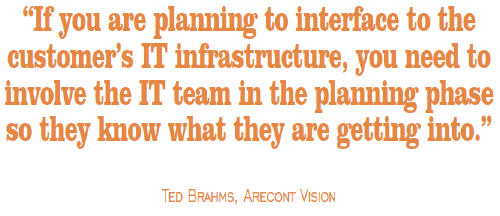5 Common Mistakes That Can Sabotage IP Video Success
By Pedro Pereira, Business Solutions magazine
Once you decide to make the jump into IP video surveillance, there are a handful of common mistakes to avoid.

IP-based cameras have revolutionized security and surveillance with levels of capacity, manageability, and flexibility that far outmatch traditional analog systems. But to succeed in selling the technology, VARs and integrators must avoid common mistakes, such as ignoring network performance and failing to manage customer expectations.
The biggest mistake of all, says Steve Gorski, general manager of the Americas for camera maker Mobotix, is to leave the business to security integrators who lack data expertise. It’s easier for IT integrators to learn security than vice versa, he says. “To me, very simply, IT resellers are missing a tremendous opportunity by not getting into security. They need to stop losing business to security integrators and start taking that first step to speak to customers.”

And when they take that step, here are five common mistakes to avoid:
1. Unmanaged Expectations
To avoid postinstallation recriminations, integrators must set expectations up front. “Try to define what the image quality is going to be, for example,” says Ted Brahms , director of field applications at IP camera maker Arecont Vision. For instance, if a customer is looking for the ability to recognize the difference between a $5 and a $20 bill, the installation will require cameras with higher pixel density than if the customer wants to capture images of license plates. Pixel density relates to the number of pixels per foot covered by the captured images.
2. Failure to Learn the Environment
Gorski recommends conducting a site survey before installing cameras to figure out how many cameras will cover a specific area, whether they should be mounted on ceilings or walls, whether the customer needs to capture nighttime images, and how powerful the cameras should be. “You need to understand what the customer is trying to achieve and pick the best camera. Some cameras are limited as to how far they can see, pan, and tilt. So if customers want to see something that is quite far away, that requires a specific camera. You may also want to recommend additional lighting to help illuminate the scene,” says Gorski.
3. Keeping IT Out
Failure to involve IT staff in an IP-based video deployment is a big mistake, says Brahms. “This is a network product, and if you are planning to interface to the customer’s IT infrastructure, you need to involve the IT team in the planning phase so they know what they are getting into,” he says. Keeping IT out of planning and training makes it much harder to solve any IP video-related issues post-installation.
4. Overloading the Network
Video can generate a lot of network traffic, and in implementations with dozens, hundreds, or even thousands of cameras, this can seriously affect network performance. That’s why Brahms recommends setting up a parallel dedicated video network with its own switches and planning for a load of 50% for optimum performance. This approach spares the data network from overload and makes it easier to secure the video network, Brahms says.
A small installation, however, doesn’t necessarily require separation from the data network, points out Gorski, who sets the threshold for a dedicated network at 40 to 50 cameras. In installations with decentralized cameras, the threshold for cameras that don’t have to record around the clock increases to 60 to 70 cameras, he says. Decentralized cameras are self-managing units with built-in DVR capabilities.

5. Failure to Test
Another area in which installation size matters relates to testing. Brahms says integrators deploying enterprise-level systems should do a test build to prevent postinstallation expenses related to troubleshooting and driver updates. “Get the cameras, components, switch, server hardware, and VMS (video management system), and build a test bed that can later be rolled out. You want to make sure that it will all work,” he says. “In a smaller system, you can forgo building a test bed. But make sure you use a combination of components that have worked for you in the past.”
